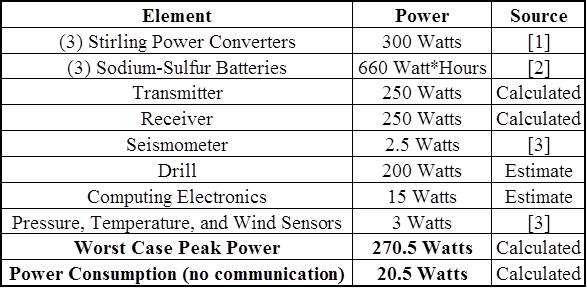Power Budget
The proposed lander will require 270.5 Watts of power during peak operation
and a minimum operational requirement of 20.5 Watts.
The power system will incorporate three (3)
Stirling power converters as detailed in the Main Power section, which together will
generate 300 Watts of electrical power. When the lander is producing more power
then it is consuming, the extra energy will be stored in three (3) 1 kg sodium-sulfur
batteries with a total capacity of 660 Watt*hours. The batteries will serve as
backup in the event that a Stirling power converter stops generating power. The
batteries will also prove useful in the event we need to transmit at an increased data rate for
a short period of time.
Two assumptions were made when developing the power budget to help determine
peak power. First, the lander will never transmit and receive at the same time.
Second, the Lander will not drill and communicate at the same time.
Our purposed power system does not incorporate a refrigeration system because
all materials used in our design can withstand the ambient temperatures of Venus.
Therefore, the expected lifetime for the power system is well over the required
90 days and ensuring a successful mission.

[1] G. A. Landis and K. C. Mellott, "Venus Surface Power and Cooling Systems," Acta Astronautica, vol. 61, pp. 995-1001, 2007.
[2] G. A. Landis and R. Harrison, "Batteries for Venus Surface Operation," Journal of Propulsion and Power,
vol. 26, p. 6, July-August 2010 2010.
[3] Jet Propulsion Laboratory, "Mission Concept Study: Planetary Science Decadal Survey:
Mars Geophysical Network," California Institute of Technology, Jet Propulsion Laboratory, 2010, p. 56.